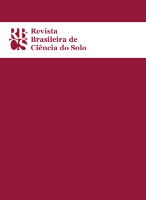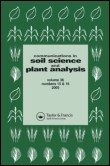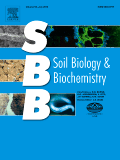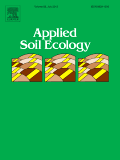
REVISTA BRASILEIRA DE CIENCIA DO SOLO
Scope & Guideline
Empowering Research in Agronomy and Soil Management
Introduction
Aims and Scopes
- Soil Fertility and Nutrient Management:
Research on soil fertility management practices, nutrient dynamics, and the application of fertilizers to enhance crop productivity and sustainability. - Soil Conservation and Management Practices:
Studies focusing on soil conservation techniques, including no-till farming, cover cropping, and agroforestry systems aimed at improving soil health and mitigating erosion. - Soil Physical and Chemical Properties:
Investigations into the physical and chemical characteristics of soils, including their structure, water retention, and nutrient availability, often in relation to land use changes. - Soil Microbiology and Ecology:
Exploration of soil microbial communities, their roles in nutrient cycling, and interactions with plants, emphasizing the importance of biodiversity in soil health. - Impact of Land Use Change on Soil Properties:
Research examining how various land use practices (e.g., agriculture, forestry, urbanization) affect soil properties and ecosystem functions. - Digital Soil Mapping and Precision Agriculture:
Utilization of technologies such as GIS, remote sensing, and machine learning for soil mapping and assessment to inform precision agriculture practices.
Trending and Emerging
- Climate Change and Soil Resilience:
Increasing focus on how soil management practices can mitigate the impacts of climate change, enhance carbon sequestration, and promote soil resilience in various ecosystems. - Sustainable Agricultural Practices:
Growing interest in practices that promote sustainability, such as agroecology, regenerative agriculture, and integrated crop-livestock systems, which balance productivity and environmental health. - Technological Innovations in Soil Science:
Emerging themes around the application of technology, including machine learning and remote sensing, for soil monitoring, mapping, and management, indicating a shift towards precision agriculture. - Soil Biodiversity and Ecosystem Services:
A rising emphasis on the role of soil biodiversity in maintaining ecosystem services, including nutrient cycling, soil health, and plant productivity. - Soil Health Indicators and Assessment:
Increased research into developing reliable indicators for assessing soil health, which can guide management practices and policy-making for sustainable land use.
Declining or Waning
- Soil Contamination and Remediation:
Research on soil contamination from heavy metals and pesticides has decreased, possibly due to a shift towards more sustainable agricultural practices and a focus on organic farming. - Traditional Tillage Practices:
There is a noticeable decline in papers focusing on conventional tillage methods, reflecting a broader acceptance and adoption of no-tillage systems in Brazil. - Historical Soil Studies:
Older studies focusing on historical soil classifications and static properties are less common, as newer research emphasizes dynamic processes and management impacts.
Similar Journals

COMMUNICATIONS IN SOIL SCIENCE AND PLANT ANALYSIS
Advancing the Science of Soil and Plant InteractionsCOMMUNICATIONS IN SOIL SCIENCE AND PLANT ANALYSIS, published by Taylor & Francis Inc, is a prestigious journal dedicated to advancing research in the fields of agronomy, crop science, and soil science. Established in 1970, the journal has maintained a significant presence over the years, with a commitment to publishing high-quality, peer-reviewed articles that contribute to the understanding of soil and plant interactions. With an impressive Q2 ranking in both Agronomy and Soil Science, it positions itself as a vital resource for researchers, professionals, and students alike, keen on exploring innovative solutions to contemporary agricultural challenges. Although it currently does not provide open access, the journal ensures wide dissemination through its established subscription services. The journal's focus on empirical research, methodologies, and technological advancements in soil management and plant nutrition makes it an essential platform for disseminating knowledge and fostering discussions within the scientific community. Located in the heart of Philadelphia, USA, it remains a significant contributor to the global dialogue on sustainable agriculture and environmental stewardship.

SOIL SCIENCE SOCIETY OF AMERICA JOURNAL
Elevating Soil Science to New HeightsWelcome to the SOIL SCIENCE SOCIETY OF AMERICA JOURNAL, a premier publication in the field of soil science, published by WILEY. With a distinguished history dating back to 1976, this journal has consistently provided a platform for researchers to share innovative findings and insights into soil’s critical role in agricultural and ecological systems. Featuring an impressive Q1 category ranking in Soil Science and positioned within the top 25% of its field according to Scopus, this journal is recognized for its impactful contributions to advancing our understanding of soil dynamics. While not an open-access journal, it remains a valuable resource for academics and professionals alike, with distinguished articles that meet the highest scientific standards. As it enters its converged years from 1976 to 2024, the journal aims to continue shaping the future of soil research, offering valuable knowledge to students, researchers, and practitioners dedicated to sustainable land management and environmental preservation.

SOIL BIOLOGY & BIOCHEMISTRY
Unveiling the Secrets Beneath Our FeetSOIL BIOLOGY & BIOCHEMISTRY, published by Pergamon-Elsevier Science Ltd, is a premier academic journal that plays a pivotal role in advancing the fields of microbiology and soil science. Established in 1969, this esteemed journal has gained recognition for its rigorous publication standards and impactful research contributions, evidenced by its prestigious Q1 rankings in both Microbiology and Soil Science categories for 2023. With an impressive Scopus rank of #3 among 159 in Agricultural and Biological Sciences and #14 among 182 in Immunology and Microbiology, it boasts a notable 98th percentile in its field. The journal offers researchers, professionals, and students a vital platform for sharing innovative studies and insights about soil ecosystems and their biochemical processes, fostering greater understanding and collaboration within the scientific community. While Open Access options are currently not available, the journal remains a cornerstone for those seeking to deepen their knowledge and contribute significantly to soil biology and biochemistry.

EURASIAN SOIL SCIENCE
Innovating solutions for soil conservation and management.EURASIAN SOIL SCIENCE, published by PLEIADES PUBLISHING INC, is a premier journal dedicated to advancing knowledge in the fields of soil science and earth-surface processes. With an ISSN of 1064-2293 and an E-ISSN of 1556-195X, this journal has been a key resource for researchers and professionals from its inception in 1992 and continues to thrive as it converges toward 2024. Situated in the United States, EURASIAN SOIL SCIENCE has achieved notable recognition, attaining a Q2 ranking in both Earth-Surface Processes and Soil Science categories as of 2023. Its Scopus rankings further underscore its importance, with Earth and Planetary Sciences placing it at #81/179 and Agricultural and Biological Sciences ranking it at #80/159. Engaging a global audience, this journal publishes cutting-edge research articles, reviews, and case studies that address critical issues related to soil health, conservation, and management. Though currently not open access, the journal offers valuable insights and fosters collaboration among scientists and practitioners, underscoring its vital role in enhancing the understanding of soil dynamics and sustainability.

APPLIED SOIL ECOLOGY
Illuminating the Role of Soils in Ecosystem ServicesApplied Soil Ecology, published by Elsevier, is a premier journal dedicated to advancing the field of soil ecology through rigorous research and innovative methodologies. With an impressive impact factor and a consistent placement in the Q1 quartile across various categories including Agricultural and Biological Sciences, Ecology, and Soil Science, this journal underscores its significance in the scientific community. The journal's scope encompasses critical areas such as soil biology, microbial ecology, and the role of soils in ecosystem services, aiming to foster collaboration and knowledge exchange among researchers, professionals, and students. The convergence of research efforts from 1994 to 2024 highlights its commitment to maintaining current and relevant discourse within the field. While open access options are not available, the quality and depth of the articles published ensure that the latest findings and discussions are accessible through institutional subscriptions. With a strong focus on empirical studies and applied research, Applied Soil Ecology is an essential resource for anyone interested in the complexities of soil ecosystems and their impact on the environment.

Soil Research
Innovating solutions for soil and environmental challenges.Soil Research, published by CSIRO PUBLISHING, is an esteemed scholarly journal dedicated to advancing the field of soil science, environmental science, and earth-surface processes. With an ISSN of 1838-675X and E-ISSN of 1838-6768, this journal serves as a vital platform for researchers and professionals to disseminate innovative findings and engage with contemporary challenges in soil and environmental management. The journal is recognized for its impactful contributions, as evidenced by its Q2 ranking in 2023 across multiple categories including Earth-Surface Processes, Environmental Science, and Soil Science, reflecting its influence and relevance in these critical academic areas. Operating from its headquarters in Clayton, Victoria, Australia, Soil Research is committed to fostering open access to research, ensuring wider dissemination of knowledge. As it converges toward its future objectives until 2024, the journal aims to provide a forum for diverse perspectives that enhance understanding and stewardship of soil resources, making it an indispensable resource for students, researchers, and industry professionals alike.

Journal of Soil Science and Plant Nutrition
Fostering sustainable practices through cutting-edge research.The Journal of Soil Science and Plant Nutrition, published by SPRINGER INT PUBL AG, is a premier academic journal dedicated to advancing the fields of agronomy, plant science, and soil science. With an impressive Q1 ranking in both Agronomy and Crop Science and Plant Science, alongside a Q2 ranking in Soil Science, this journal stands at the forefront of innovative research and knowledge dissemination. Annually indexed in key databases, it provides a platform for high-quality research articles that explore the complex interactions between soil health and plant nutrition, contributing significantly to sustainable agricultural practices. Although it does not offer open access options, the journal is accessible through various academic institutions and libraries, ensuring a wide readership. With its emphasis on impactful findings, the journal is an essential resource for researchers, professionals, and students aiming to further their understanding and application of soil and plant science in an ever-evolving global context.

CANADIAN JOURNAL OF SOIL SCIENCE
Cultivating Insights for Healthier EcosystemsThe Canadian Journal of Soil Science (ISSN: 0008-4271, E-ISSN: 1918-1841) is a premier publication in the field of soil science, proudly published by Canadian Science Publishing. Established in 1974, this esteemed journal aims to promote high-quality research and insights into the dynamic interactions within soil ecosystems, addressing pressing issues such as soil health, management, and sustainability. With an impressive 2023 category quartile ranking of Q2 in Soil Science and a Scopus ranking placing it in the 52nd percentile, this journal stands out as a key resource for researchers, professionals, and students alike. Although currently not open access, the journal provides valuable content that contributes to advancing the understanding of soil science, an essential discipline for agricultural innovation and environmental stewardship. As we approach its converged years through 2024, the Canadian Journal of Soil Science is poised to continue its pivotal role in disseminating impactful research and fostering a community dedicated to soil science excellence.

Malaysian Journal of Soil Science
Pioneering Sustainable Practices for Soil and Crop Health.The Malaysian Journal of Soil Science, published by the Malaysian Society of Soil Science, serves as a vital platform for disseminating high-quality research in the fields of Agronomy and Crop Science as well as Soil Science. With an ISSN of 1394-7990, this peer-reviewed journal has made significant strides since its establishment in 2009, currently positioned in the Q2 quartile for both categories as of 2023. The journal aims to advance knowledge surrounding soil health and management practices, particularly within the Malaysian context, while also addressing global soil science issues. Despite being based in Malaysia, it welcomes contributions from a diverse range of geographies and viewpoints, enriching the academic discourse. Researchers and practitioners in this field will find a wealth of innovative studies and findings that reflect the current trends and challenges in soil management. Given its current rankings in Scopus, the journal plays a crucial role in shaping the future of soil science, making it indispensable for anyone dedicated to advancing research and practical applications in agricultural and environmental sciences.

Soil Systems
Advancing Soil Science for a Sustainable FutureSoil Systems, published by MDPI, is a premier open access journal dedicated to advancing the understanding of soil science and earth-surface processes. Launched in 2017, this journal has quickly established itself with a strong presence in the academic community, holding a prestigious Q1 ranking in both Earth-Surface Processes and Soil Science as of 2023. With an impressive Scopus rank in the top 20% of its categories, Soil Systems is an essential platform for disseminating groundbreaking research addressing the challenges and complexities of soil management, its ecological significance, and its role in sustainable development. The journal operates under an open access model since 2018, ensuring maximum visibility and accessibility for researchers, professionals, and students alike. Based in Switzerland, at ST ALBAN-ANLAGE 66, CH-4052 BASEL, Soil Systems encourages contributions that promote interdisciplinary collaboration, innovative methodologies, and the application of findings to real-world issues related to soil health and environmental sustainability.